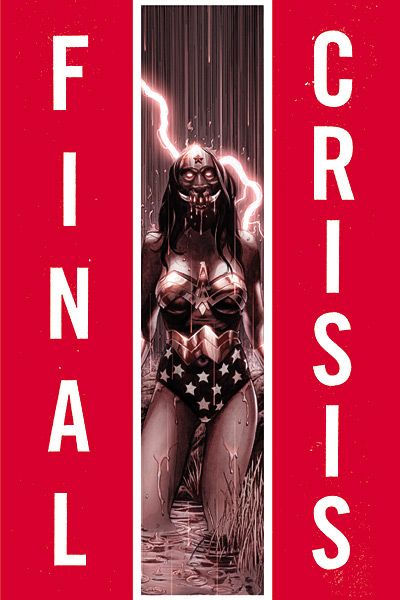If you've been confused by the first two issues of "Final Crisis," issue #3 should clear things up a bit. Grant Morrison and J. G. Jones show us explicitly the link between the mysterious Libra and the forces of evil. They show us what happened with the three Flashes and the time-travelling bullet. They explain the presence of the Atomic Knights in Bludhaven. They show the heroes preparing for war. But even though all of these straightforward explanations are given, it's still a Morrison/Jones comic, and they throw in plenty of new ideas to go along with the exposition.
Once again, Morrison begins an issue of "Final Crisis" with a disorienting scene that might baffle casual readers. This one features Frankenstein, a bunch of government agents, the enigmatic new Father Time, the Question, and a Nazi Supergirl who has fallen from the sky. Personally, I prefer the opening scene to much of the rest of the issue. I'm sure other readers, though, will be glad to see the dots connected. They'll be thankful that things in the middle of the issue stop jumping around and settle into to a more comfortable pace. The bulk of this issue is relatively straightforward, with the good guys assembling to confront the enemy. It's a typical moment from any "Crisis" story, where someone (or some thing) rounds up all the heroes and tells them they have to work together to overcome impossible odds. This time, it's "Article X," the WWII-era superhero draft policy that gathers the heroes together. As Alan Scott points out, with the New Gods out of the picture, they have no one to balance out Darkseid's evil. Hence, the need for an army. Hence, the draft.
But I still like the insanity of the opening scene the best because it doesn't go out of its way to explain itself. It's enough to know that the government has plans for Rene Montoya, and enough to know that she's looking for answers. It's enough to know that a Nazi Supergirl has fallen to Earth, and that's a bad thing either way: (a) she'll wake up, and, hey, Nazi Supergirl on Earth! Or (b) she's dead and if there's a power out there strong enough to kill a Nazi Supergirl, Earth's probably in trouble. I'm sure we'll learn more about these plot elements in future issues, but what I've liked about "Final Crisis" so far is its willingness to throw so many images and ideas into the mix, without bothering to explain every single one along the way. With issue #3, we're getting into the explanation phase, which is necessary, of course, but it sucks a bit of the life out of the story for me. Not enough to make it dull, but enough to remind me of some of Geoff Johns' work on "Justice Society of America" in which dozens of costumed characters stand around talking about things I already know. That's just the middle of "Final Crisis" #3, and it doesn't detract too much from the work as a whole.
One of the things Morrison and Jones are doing in this series is giving the more obscure characters a turn in the mega-event spotlight. Batman was quickly removed from action in issue #1, Superman is too busy trying to keep Lois Lane alive, and now Wonder Woman has been taken off the board as well. The assembled "army" of heroes contains many familiar faces, like Hawkman, Nightwing, and Power Girl, but it's the characters like Sonny Sumo and the Super Young Team who are being set up as the ones who will turn the tide. And that makes the series more fun than just watching Superman punch his way to victory.
The first three issues of "Final Crisis" have set the stage, as advertised, and after a short break for some ancillary series and one-shots, "Final Crisis" will return with a new focus, I'm sure: the heroes are assembled, now they need to figure out what to do. As much as I've liked "Crisis on Infinite Earths" and "Identity Crisis," they were designed as continuity fixes first, and stories second. "Final Crisis" is, above all, a story. And it's unfolding a bit differently than the other two series, but I think it's much better for it.

